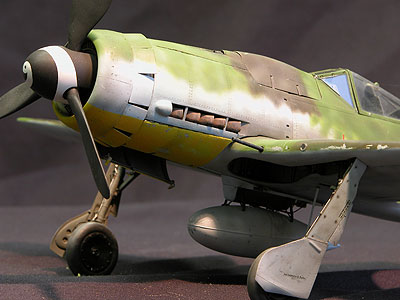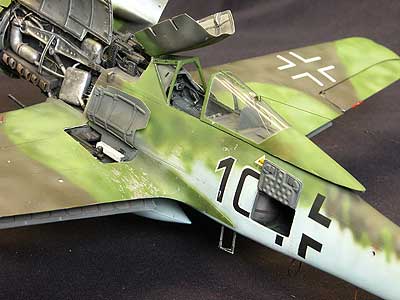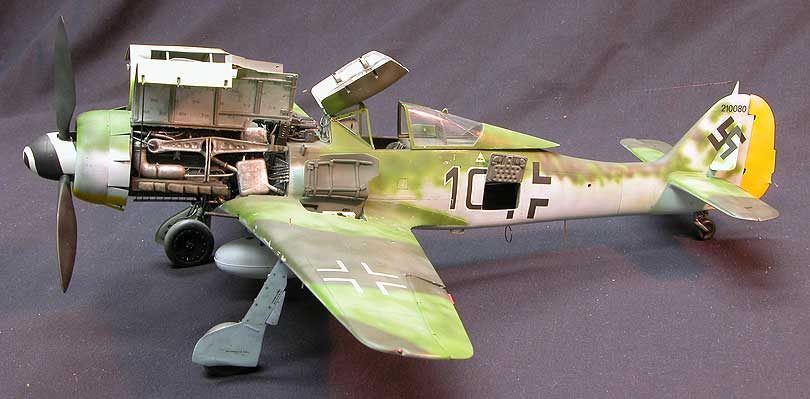
 |
|
1/32nd
scale |
|
III/JG
54
December 1944 |
|
1982
International Plastic Modeler's Society USA
National Convention Judge's Grand Award winner. |

|
INTRODUCTION When this model was built in the 1976-1981 timeframe, the Focke Wulf 190D-9 was not the well documented aircraft is it today. The availability of a multitude of PE, resin parts and excellent kits as well as a variety of known markings, one can build an accurate and detailed model without the huge amount of scratchbuilding I had to do. I've seen some very well done D-9 models on various web magazine sites. The challenge I faced, and would still face today, was making the parts move and still keep them in scale. I was a year into the project before I found a materials solution and construction technique to make scale piano hinges. The piano hinges I eventually made measure .0075 inches in diameter. I had no idea how to approach many of the working parts problems but knew that I would eventually solve them. I also wanted to make as much of the model out of plastic as possible as I was a hardcore IPMSer (possibly AMSer) at the time. If I were to undertake such a project today, I would use more metal and maybe double the scale to 1/16th like the aircraft of Fine Art Models (www.fine-art-models.com). This Fw-190D-9 model is so fragile only I can operate the parts. John Ficklen said he did try some of them out during judging at the 1982 IPMS Nationals...he wanted to confirm they actually worked. The accuracy of current kits and availability of vast amounts of after market parts makes plastic modeling completely different than it was twenty five years ago. The current crop of plastic modelers could get some great inspiration by checking out the works of Arlo Schroeder, John Alcorn, Frank Mitchell and the late, great George Lee. The photographs for this web site were taken during the week of 28 December 2003.
A number of parts from three Revell 1/32 scale Fw 190D kits (No. 215) and one Hasegawa 1/32 Fw 190A kit (No. S10) were used, but around 90 percent of the model is scratchbuilt. Many of kit parts served primarily as masters from which vacuum-formed or stretch-formed thinner replacements were fabricated. ENGINE COMPARTMENT Except for the propeller and spinner (modified Revell kit parts), Grandt Line HO railroad bolts and Kemtron pipe unions, all components in this area are scratchbuilt. Materials include styrene, PVC, ABS, aluminum tubing, Squadron Green Putty, Duratite white putty, various thicknesses of solder, copper and brass wire. The engine doors are hinged as on the actual aircraft to expose the Junkers Jumo 213A-1 engine and engine compartment. The vacuum-formed doors are held closed by three functional latches on the lower panels and six (three on each side) functional sliding locks on the side panels. Because these large, thin doors do not maintain form unless secured, these locks and latches actually hold the doors in place. The metal finish on the inside of the doors is silver Rub'nBuff, graphite and various mixtures of paint. Everything forward of the firewall is attached to the firewall by the engine mount. Artist's note: Getting the hinging doors, latches and locating points lined up was very time consuming. Scratchbuilding all the detail was a great deal of fun work, but making the parts operate increased construction time by 25 percent. Not only did parts have to look scale, they had to actually fit and align correctly into fuselage and wing openings. |
 |
|
 |
 |
|
|